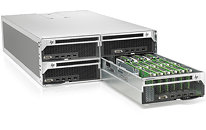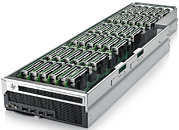Thursday, November 3rd 2011

HP Shapes the Future of Extreme Low-energy Server Technology
HP today announced a new industry program comprising a new server development platform, customer discovery lab and partner ecosystem to help customers significantly reduce complexity, energy use and costs.
HP's new program, dubbed Project Moonshot, combines with HP Converged Infrastructure technology to allow the sharing of resources - including storage, networking, management, power and cooling - across thousands of servers. It paves the way to the future of low-energy computing for emerging web, cloud and massive scale environments.Project Moonshot is designed to fuel the advancement of low-energy server technology, while promoting industry collaboration to break new ground in "hyperscale" computing environments such as cloud services and on-demand computing.
Through these efforts, data center efficiencies are expected to reach new heights for select workloads and applications, consuming up to 89 percent less energy and 94 percent less space, while reducing overall costs up to 63 percent compared to traditional server systems.
For companies with thousands of servers delivering web services, social media and simple content delivery applications, Project Moonshot is designed to deliver improved simplicity while achieving energy and cost savings never before possible.
Project Moonshot is based on experience gained through HP's leading low-energy innovations such as HP Data Center Smart Grid, which enables customers to double or triple their data center capacity, as well as the recently announced HP EcoPOD, the world's most efficient data center. The Project Moonshot infrastructure is an extension of the industry-leading HP ProLiant brand of servers, which incorporates traditional x86 processors from Intel and AMD, and which has been the top server choice for 61 quarters.
"Companies with hyperscale environments are facing a crisis in capacity that requires a fundamental change at the architectural level," said Paul Santeler, vice president and general manager, Hyperscale Business Unit, Industry Standard Servers and Software, HP. "HP has a strong track record of leading market transitions that enable our clients to stay ahead of the technology curve, maximize their ability to innovate and speed their time to market of new services while reducing costs and energy use."
Unlocking the potential of extreme low-energy servers
Project Moonshot is a multiyear, multi-phased program that builds on HP's experience powering the world's largest cloud infrastructures and 10 years of extensive low-energy computing infrastructure research from HP Labs, the company's central research arm.
Reinventing the traditional approach to data center infrastructure by using Converged Infrastructure as its foundation, Project Moonshot unlocks the promise of emerging extreme low-energy servers by pooling resources in a highly federated environment to radically reduce space requirements, management complexity and energy consumption. It includes three essential elements to support the industry's evolution to hyperscale computing:
The HP Redstone Server Development Platform is the first in a line of HP server development platforms that feature extreme low-energy server processors. Initially incorporating Calxeda EnergyCore ARM Cortex processors, future Redstone versions will include Intel Atom-based processors as well as others. HP Redstone is designed for testing and proof of concept. It incorporates more than 2,800 servers in a single rack, reducing cabling, switching and the need for peripheral devices, and delivering a 97 percent reduction in complexity. The initial HP Redstone platform is expected to be available in limited volumes to select customers in the first half of next year.
The HP Discovery Lab enables clients to experiment, test and benchmark applications on the HP Redstone Server Development Platform, and other extreme low-energy platforms, as well as on traditional servers. The first lab is scheduled to open in Houston in January, with additional sites planned to open in Europe and Asia. With remote or onsite access, clients can work directly with HP engineers and industry peers to learn about the benefits of extreme low-energy servers for their specific application needs.
The HP Pathfinder Program, part of the HP AllianceONE partner program, is dedicated to client discovery efforts across the data center. It also encourages development of elements of the Project Moonshot program within open industry standards. The program includes independent software vendors - compute, storage and networking partners who contribute hardware, software and technical expertise. Initial participants are expected to include AMD, ARM Holdings, Calxeda, Canonical and Red Hat, with additional partners to be announced as the program develops.
"The volume of data processed in financial markets has increased exponentially, and traditional scale-up or scale-out architectures are struggling to keep up with demand without vastly increasing cost and power usage," said Niall Dalton, director of High-Frequency Trading at Cantor Fitzgerald, a company that is currently evaluating the technology. "HP is taking a holistic approach to solving this problem and working to bring unprecedented energy and cost savings for tomorrow's large-scale, data-intensive applications."
Additional information about Project Moonshot is available here.
HP Converged Infrastructure is a key foundation of an Instant-On Enterprise. In a world of continuous connectivity, the Instant-On Enterprise embeds technology in everything it does to serve customers, employees, partners and citizens with whatever they need, instantly.
HP's premier client event, HP DISCOVER, takes place Nov. 29 - Dec. 1 in Vienna, Austria. The event showcases how organizations can get started on their Instant-On Enterprise journeys.
HP's new program, dubbed Project Moonshot, combines with HP Converged Infrastructure technology to allow the sharing of resources - including storage, networking, management, power and cooling - across thousands of servers. It paves the way to the future of low-energy computing for emerging web, cloud and massive scale environments.Project Moonshot is designed to fuel the advancement of low-energy server technology, while promoting industry collaboration to break new ground in "hyperscale" computing environments such as cloud services and on-demand computing.
Through these efforts, data center efficiencies are expected to reach new heights for select workloads and applications, consuming up to 89 percent less energy and 94 percent less space, while reducing overall costs up to 63 percent compared to traditional server systems.
For companies with thousands of servers delivering web services, social media and simple content delivery applications, Project Moonshot is designed to deliver improved simplicity while achieving energy and cost savings never before possible.
Project Moonshot is based on experience gained through HP's leading low-energy innovations such as HP Data Center Smart Grid, which enables customers to double or triple their data center capacity, as well as the recently announced HP EcoPOD, the world's most efficient data center. The Project Moonshot infrastructure is an extension of the industry-leading HP ProLiant brand of servers, which incorporates traditional x86 processors from Intel and AMD, and which has been the top server choice for 61 quarters.
"Companies with hyperscale environments are facing a crisis in capacity that requires a fundamental change at the architectural level," said Paul Santeler, vice president and general manager, Hyperscale Business Unit, Industry Standard Servers and Software, HP. "HP has a strong track record of leading market transitions that enable our clients to stay ahead of the technology curve, maximize their ability to innovate and speed their time to market of new services while reducing costs and energy use."
Unlocking the potential of extreme low-energy servers
Project Moonshot is a multiyear, multi-phased program that builds on HP's experience powering the world's largest cloud infrastructures and 10 years of extensive low-energy computing infrastructure research from HP Labs, the company's central research arm.
Reinventing the traditional approach to data center infrastructure by using Converged Infrastructure as its foundation, Project Moonshot unlocks the promise of emerging extreme low-energy servers by pooling resources in a highly federated environment to radically reduce space requirements, management complexity and energy consumption. It includes three essential elements to support the industry's evolution to hyperscale computing:
The HP Redstone Server Development Platform is the first in a line of HP server development platforms that feature extreme low-energy server processors. Initially incorporating Calxeda EnergyCore ARM Cortex processors, future Redstone versions will include Intel Atom-based processors as well as others. HP Redstone is designed for testing and proof of concept. It incorporates more than 2,800 servers in a single rack, reducing cabling, switching and the need for peripheral devices, and delivering a 97 percent reduction in complexity. The initial HP Redstone platform is expected to be available in limited volumes to select customers in the first half of next year.
The HP Discovery Lab enables clients to experiment, test and benchmark applications on the HP Redstone Server Development Platform, and other extreme low-energy platforms, as well as on traditional servers. The first lab is scheduled to open in Houston in January, with additional sites planned to open in Europe and Asia. With remote or onsite access, clients can work directly with HP engineers and industry peers to learn about the benefits of extreme low-energy servers for their specific application needs.
The HP Pathfinder Program, part of the HP AllianceONE partner program, is dedicated to client discovery efforts across the data center. It also encourages development of elements of the Project Moonshot program within open industry standards. The program includes independent software vendors - compute, storage and networking partners who contribute hardware, software and technical expertise. Initial participants are expected to include AMD, ARM Holdings, Calxeda, Canonical and Red Hat, with additional partners to be announced as the program develops.
"The volume of data processed in financial markets has increased exponentially, and traditional scale-up or scale-out architectures are struggling to keep up with demand without vastly increasing cost and power usage," said Niall Dalton, director of High-Frequency Trading at Cantor Fitzgerald, a company that is currently evaluating the technology. "HP is taking a holistic approach to solving this problem and working to bring unprecedented energy and cost savings for tomorrow's large-scale, data-intensive applications."
Additional information about Project Moonshot is available here.
HP Converged Infrastructure is a key foundation of an Instant-On Enterprise. In a world of continuous connectivity, the Instant-On Enterprise embeds technology in everything it does to serve customers, employees, partners and citizens with whatever they need, instantly.
HP's premier client event, HP DISCOVER, takes place Nov. 29 - Dec. 1 in Vienna, Austria. The event showcases how organizations can get started on their Instant-On Enterprise journeys.


10 Comments on HP Shapes the Future of Extreme Low-energy Server Technology
Though i do believe part of this is moving away from Virtulisation and every VM actually runs on its own quad core arm CPU. Its an interesting concept and I want to see how it pans out.
I also wonder what those dozens of SATA connectors are ment for... to actually connect drives?
Just in time for spec definitions for next years project proposals.
HP we need benchies.